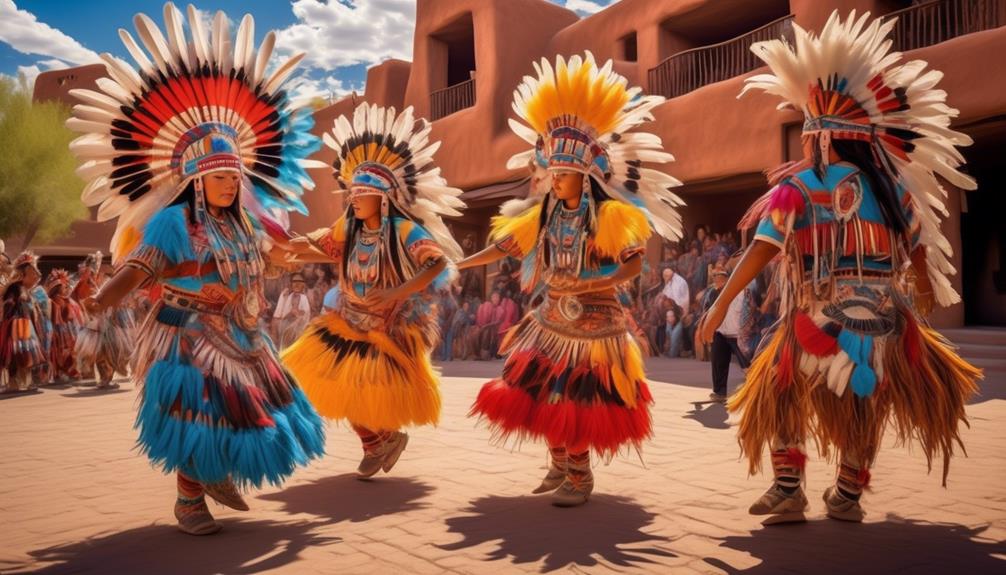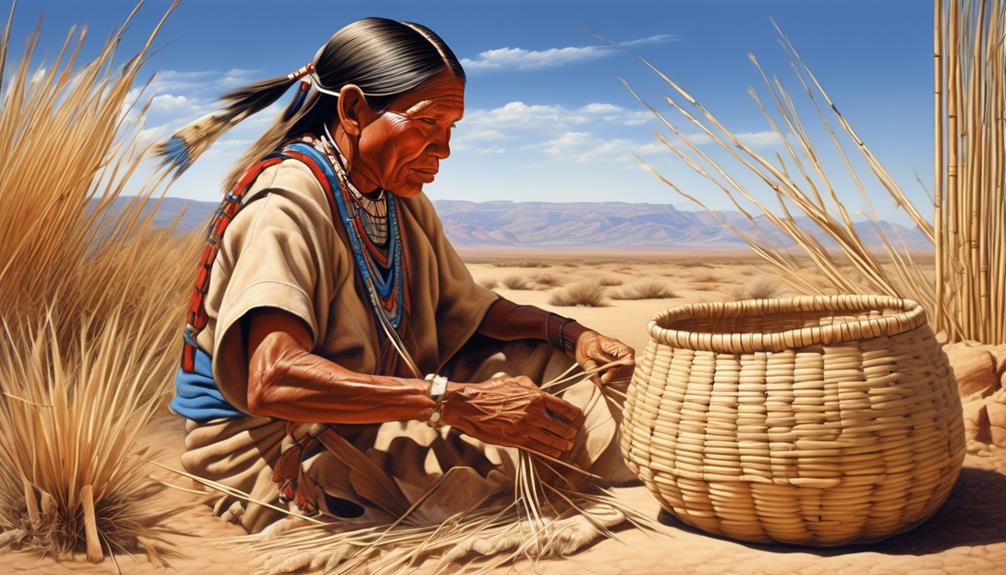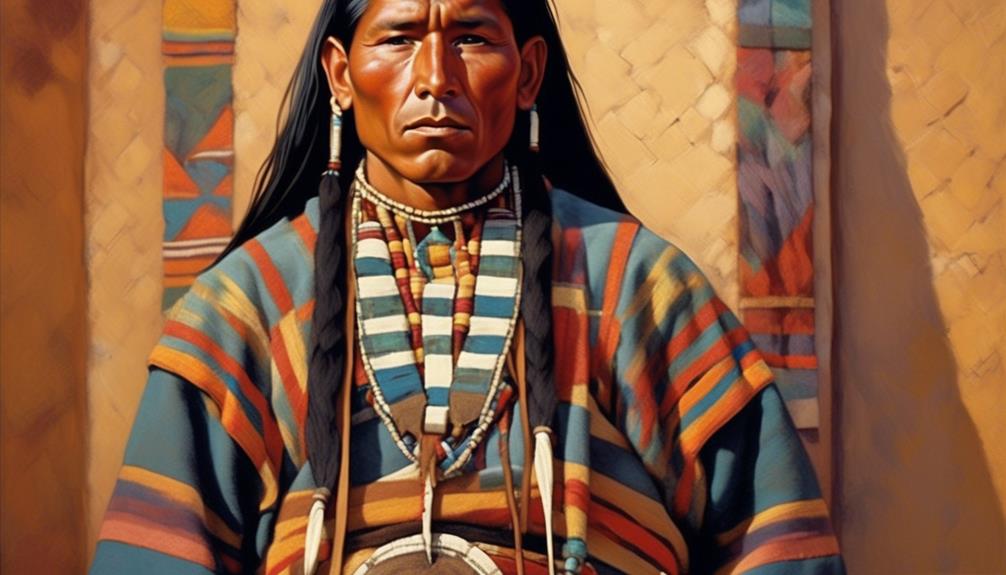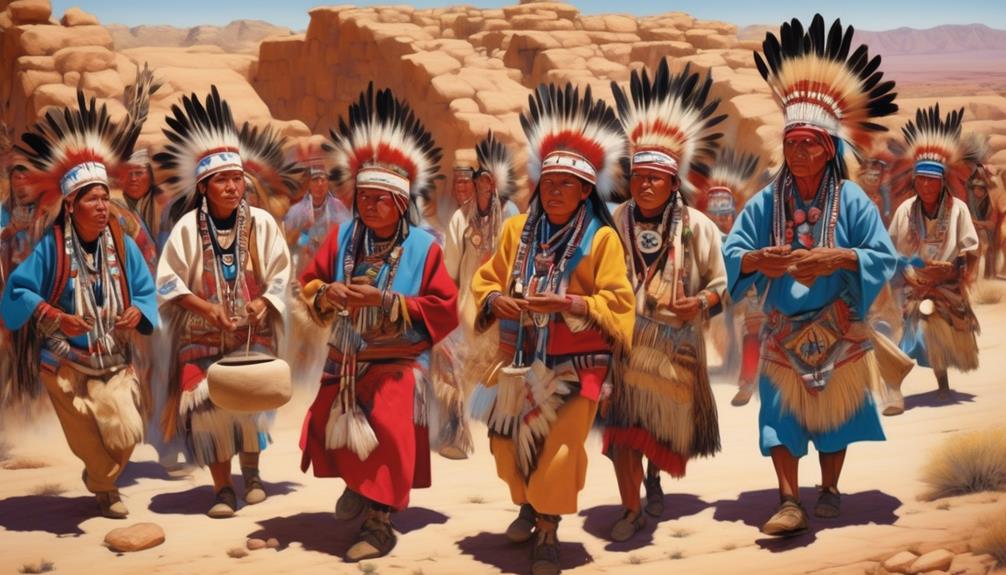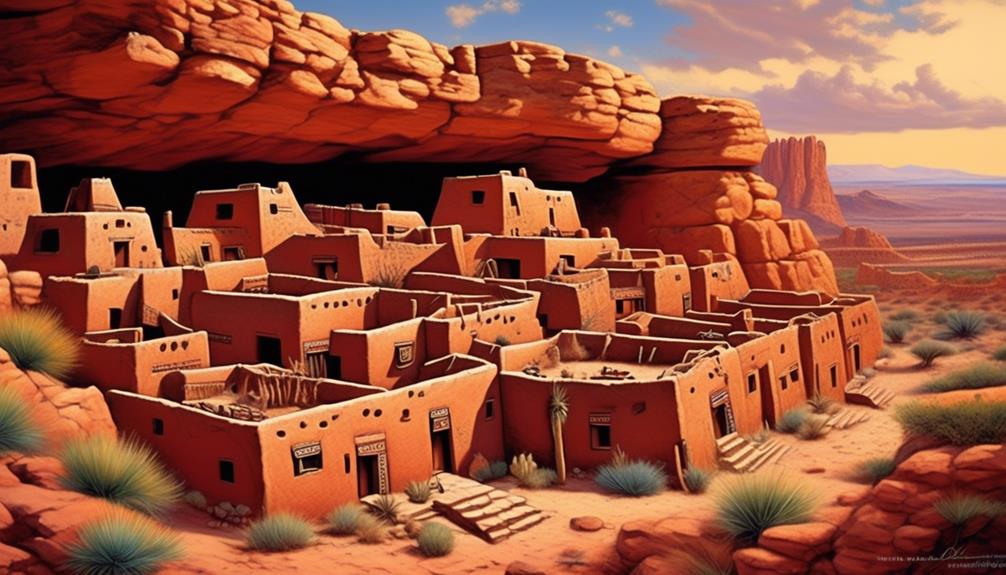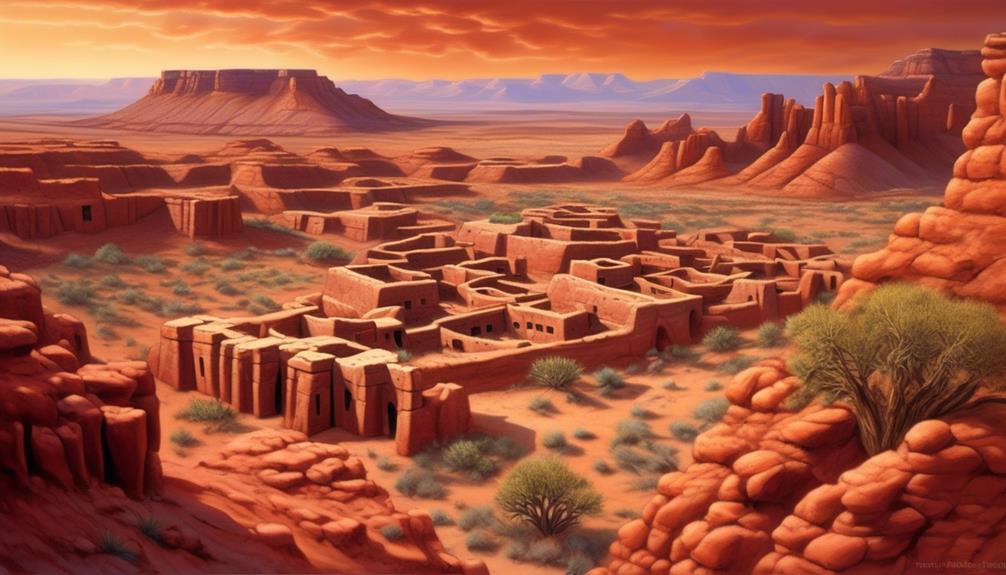As we stand on the brink of the harsh desert, with the dusty ground below us and the vast sky above, we can’t help but ponder the ancient traditions of the Hopi tribe.
Their well-known reputation for intricate pottery traditions, vibrant ceremonial dances, and deep connection to the land has fascinated scholars and enthusiasts for generations.
But what else lies beneath the surface of their rich cultural tapestry, and how did these traditions shape their identity and way of life?
Key Takeaways
- Developed sustainable farming techniques, including terraced farming, complex irrigation systems, and crop rotation
- Known for precision and intricacy in pottery making, utilizing the coiling technique and creating pottery with intricate designs
- Vibrant ceremonial dances that exemplify rich cultural traditions, spiritual connections, and the preservation of Hopi cultural identity
- Deep connection to the land, practicing sustainable farming methods and viewing themselves as stewards of the earth, with a holistic approach to sustainable living
Ancient Agricultural Practices
The Hopi tribe developed sophisticated and sustainable agricultural practices that were essential for their survival in the arid Southwest region of the United States. Their ancient farming techniques were remarkably advanced for their time, allowing them to sustainably produce food in an environment with minimal annual rainfall. The Hopi successfully cultivated crops such as corn, beans, and squash, using innovative methods like terraced farming and a complex irrigation system to efficiently manage water in the arid climate.
Their sustainable food production was characterized by a deep understanding of the land and its resources, as well as a profound respect for the natural environment. The Hopi people carefully selected and cultivated crop varieties that were well-suited to the arid conditions, demonstrating a high level of agricultural knowledge and adaptation. Additionally, they practiced crop rotation and soil conservation to maintain the fertility of their farmland, ensuring long-term sustainability.
These ancient agricultural practices weren't only crucial for the survival of the Hopi tribe but also serve as a testament to their ingenuity and resourcefulness in the face of challenging environmental conditions.
Intricate Pottery Traditions

Developing intricate pottery traditions, the Hopi tribe utilized their artistic skills and cultural knowledge to create unique and functional pottery pieces that reflected their deep connection to the natural world.
The pottery techniques employed by the Hopi were renowned for their precision and intricacy. One notable method was the use of coiling, where long strands of clay were coiled on top of each other to form the shape of the vessel. This technique allowed for the creation of large, durable pottery pieces.
Additionally, the Hopi artisans were known for their exceptional skill in painting and carving intricate designs onto the pottery. These artistic designs often depicted symbols and motifs that held spiritual and cultural significance for the tribe.
The pottery not only served utilitarian purposes but also held symbolic and ceremonial importance within the Hopi culture. Each piece of pottery was a testament to the tribe's reverence for the natural world and their commitment to preserving their cultural heritage through artistic expression.
The Hopi pottery continues to be celebrated for its exquisite craftsmanship and the deep cultural significance it embodies.
Vibrant Ceremonial Dances
With rhythmic movements and vibrant costumes, the Hopi tribe's ceremonial dances exemplify their rich cultural traditions and spiritual connections. These dances are deeply rooted in the Hopi way of life and hold immense cultural significance. The traditional clothing worn during these dances is an essential element that symbolizes the tribe's heritage and values. The dancers' attire often features intricate designs and vibrant colors, reflecting the tribe's connection to the natural world and the spiritual significance of the dance.
| Cultural Significance | Traditional Clothing |
|---|---|
| Represents spiritual beliefs and traditional values | Elaborate, vibrant costumes with symbolic designs |
| Connects the community with their ancestral heritage | Reflects the tribe's close relationship with the natural world |
| Preserves and celebrates the Hopi cultural identity | Embodies the spiritual significance of the ceremonial dances |
The ceremonial dances serve as a means of preserving and celebrating the Hopi cultural identity while fostering a strong sense of community and spiritual connection. The intricate traditional clothing worn by the dancers adds a visual dimension to the cultural significance of these vibrant and captivating performances.
Deep Connection to the Land

Rooted deeply in our ancestral traditions, the Hopi tribe's connection to the land is a fundamental aspect of their cultural identity. This profound relationship with the earth shapes every aspect of their lives, from agricultural practices to spiritual beliefs. The following factors underscore the significance of the Hopi tribe's deep connection to the land:
- Sustainable Farming: The Hopi people have practiced sustainable farming for centuries, utilizing traditional methods such as dry farming and crop rotation. This approach not only ensures the tribe's food security but also maintains the health of the land for future generations.
- Environmental Stewardship: The Hopi tribe views themselves as stewards of the earth, responsible for preserving the natural world for their descendants. This ethos guides their interactions with the environment, leading to a harmonious coexistence with nature.
- Respect for Natural Resources: The Hopi people hold a deep reverence for the earth's resources, utilizing them judiciously and with gratitude. This mindset fosters a sustainable relationship with the land, promoting ecological balance and resilience.
- Cultural Preservation: The Hopi tribe's connection to the land is intrinsically linked to the preservation of their cultural heritage. By maintaining sustainable agricultural practices and environmental stewardship, they safeguard their traditions for future generations.
The Hopi tribe's deep connection to the land epitomizes a holistic approach to sustainable living, integrating cultural values with environmental responsibility.
Spiritual Ceremonies and Traditions
The deep spiritual connection to the land maintained by the Hopi tribe seamlessly intertwines with their rich tapestry of ceremonial practices and traditional customs. Hopi religious beliefs are deeply rooted in the spiritual essence of their existence, and their ceremonial rituals play a vital role in upholding these beliefs.
The traditional spiritual practices of the Hopi tribe hold immense cultural significance, serving as a means of preserving their heritage and connecting with their ancestors. Ceremonial rituals are integral to the Hopi way of life, with each ritual carrying specific meanings and purposes that are passed down through generations. These rituals often center around agricultural cycles, prayers for rain, and the overall well-being of the community.
The Hopi tribe's religious beliefs are intricately woven into these ceremonies, emphasizing the importance of harmony, balance, and respect for the natural world. Furthermore, the traditional spiritual practices of the Hopi tribe reflect their deep reverence for the interconnectedness of all living beings and the Earth. These practices encompass various ceremonies, dances, and rites that honor their history, spirituality, and the teachings of their ancestors.
The cultural significance of these traditions can't be overstated, as they serve as a guiding force in preserving the essence of the Hopi tribe's identity and spiritual legacy.
Frequently Asked Questions
What Is the Hopi Tribe's Belief System and Religious Practices?
We'll discuss the Hopi tribe's belief system and ritual practices.
The Hopi belief system centers around the reverence for nature and the spiritual connection to the land. Their religious practices involve elaborate ceremonies and rituals to honor their deities and maintain harmony within the community.
These rituals often include dances, songs, and symbolic gestures that play a vital role in preserving the tribe's cultural identity and spiritual heritage.
How Has the Hopi Tribe's Language and Oral Traditions Been Preserved Over Time?
Preservation methods for the Hopi Tribe's language and oral traditions have been varied and successful. Language revitalization efforts include immersion programs for youth, community language classes, and the use of technology for documentation.
Oral traditions are passed down through storytelling and ceremonial practices. These methods ensure the continued vitality of our language and cultural heritage.
As the old adage goes, 'A people without the knowledge of their past history, origin and culture is like a tree without roots.'
What Traditional Foods and Cooking Methods Are Significant to the Hopi Tribe?
Traditional foods and cooking methods are significant to the Hopi tribe. The Hopi people have a rich culinary tradition, with a focus on corn, beans, and squash.
Cooking methods such as stone boiling and clay pot cooking are integral to their food preparation. These techniques have been passed down through generations, contributing to the preservation of their cultural heritage.
The Hopi's deep connection to the land is reflected in their traditional foods and cooking practices.
Can You Explain the Role of Storytelling and Oral History in Hopi Culture?
Storytelling plays a vital role in Hopi culture, serving as a means of cultural preservation. Through oral history, our traditions, values, and beliefs are passed down from generation to generation.
Elders share tales that offer insights into our origins, experiences, and spiritual connections. These stories help us maintain a strong sense of identity and community, ensuring that our heritage continues to thrive.
How Does the Hopi Tribe Govern Itself and Make Decisions Within the Community?
In our community governance, the decision-making process is rooted in traditions and consensus-building. The Hopi tribe values collective input and respects the wisdom of elders.
Our governance structure is based on maintaining harmony and balance within the community. Decisions are often made through inclusive discussions and ceremonies, where the voices of all members are heard.
This approach fosters unity and ensures that the well-being of the community remains at the forefront of our choices.
Conclusion
In conclusion, the Hopi tribe was well known for their ancient agricultural practices, intricate pottery traditions, vibrant ceremonial dances, deep connection to the land, and spiritual ceremonies and traditions.
Their unique way of life and rich cultural heritage continue to be a source of fascination and inspiration for many people today.
It's no coincidence that the Hopi tribe has left a lasting legacy that continues to be celebrated and respected by people around the world.
Mary is a passionate writer who brings creativity and a fresh perspective to our team. Her words have the power to captivate and inspire, making her an essential contributor to our content. Mary’s commitment to storytelling and dedication to promoting Indigenous culture ensures that her work touches the hearts of our readers. We’re fortunate to have her as part of our team.
